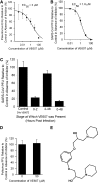Identification of novel small-molecule inhibitors of severe acute respiratory syndrome-associated coronavirus by chemical genetics
- PMID: 15380189
- PMCID: PMC7128553
- DOI: 10.1016/j.chembiol.2004.07.013
Identification of novel small-molecule inhibitors of severe acute respiratory syndrome-associated coronavirus by chemical genetics
Abstract
The severe acute respiratory syndrome-associated coronavirus (SARS-CoV) infected more than 8,000 people across 29 countries and caused more than 900 fatalities. Based on the concept of chemical genetics, we screened 50,240 structurally diverse small molecules from which we identified 104 compounds with anti-SARS-CoV activity. Of these 104 compounds, 2 target the SARS-CoV main protease (M(pro)), 7 target helicase (Hel), and 18 target spike (S) protein-angiotensin-converting enzyme 2 (ACE2)-mediated viral entry. The EC(50) of the majority of the 104 compounds determined by SARS-CoV plaque reduction assay were found to be at low micromolar range. Three selected compounds, MP576, HE602, and VE607, validated to be inhibitors of SARS-CoV M(pro), Hel, and viral entry, respectively, exhibited potent antiviral activity (EC(50) < 10 microM) and comparable inhibitory activities in target-specific in vitro assays.
Figures




Similar articles
-
Angiotensin-converting enzyme 2 is a functional receptor for the SARS coronavirus.Nature. 2003 Nov 27;426(6965):450-4. doi: 10.1038/nature02145. Nature. 2003. PMID: 14647384 Free PMC article.
-
Identification of critical determinants on ACE2 for SARS-CoV entry and development of a potent entry inhibitor.Virology. 2006 Jun 20;350(1):15-25. doi: 10.1016/j.virol.2006.01.029. Epub 2006 Feb 28. Virology. 2006. PMID: 16510163 Free PMC article.
-
Vesicular stomatitis virus pseudotyped with severe acute respiratory syndrome coronavirus spike protein.J Gen Virol. 2005 Aug;86(Pt 8):2269-2274. doi: 10.1099/vir.0.80955-0. J Gen Virol. 2005. PMID: 16033974
-
Severe acute respiratory syndrome coronavirus entry as a target of antiviral therapies.Antivir Ther. 2007;12(4 Pt B):639-50. Antivir Ther. 2007. PMID: 17944271 Review.
-
SARS-CoV replication and pathogenesis in an in vitro model of the human conducting airway epithelium.Virus Res. 2008 Apr;133(1):33-44. doi: 10.1016/j.virusres.2007.03.013. Epub 2007 Apr 23. Virus Res. 2008. PMID: 17451829 Free PMC article. Review.
Cited by
-
Computer-aided Design of Wide-spectrum Coronavirus Helicase NSP13 Cage Inhibitors: A Molecular Modelling Approach.Curr Comput Aided Drug Des. 2024;20(7):1027-1041. doi: 10.2174/0115734099247900231016055626. Curr Comput Aided Drug Des. 2024. PMID: 37921184
-
Structure and function of SARS-CoV and SARS-CoV-2 main proteases and their inhibition: A comprehensive review.Eur J Med Chem. 2023 Nov 15;260:115772. doi: 10.1016/j.ejmech.2023.115772. Epub 2023 Aug 28. Eur J Med Chem. 2023. PMID: 37659195 Review.
-
Coronaviruses SARS-CoV, MERS-CoV, and SARS-CoV-2 helicase inhibitors: a systematic review of invitro studies.J Virus Erad. 2023 Jun;9(2):100327. doi: 10.1016/j.jve.2023.100327. Epub 2023 May 26. J Virus Erad. 2023. PMID: 37363132 Free PMC article. Review.
-
Development and application of ribonucleic acid therapy strategies against COVID-19.Int J Biol Sci. 2022 Aug 1;18(13):5070-5085. doi: 10.7150/ijbs.72706. eCollection 2022. Int J Biol Sci. 2022. PMID: 35982905 Free PMC article. Review.
-
An overview of key potential therapeutic strategies for combat in the COVID-19 battle.RSC Adv. 2020 Jul 28;10(47):28243-28266. doi: 10.1039/d0ra05434h. eCollection 2020 Jul 27. RSC Adv. 2020. PMID: 35685027 Free PMC article. Review.
References
-
- World Health Organization (WHO). (www.who.int/csr/sars/en/).
-
- Ksiazek T.G., Erdman D., Goldsmith C.S., Zaki S.R., Peret T., Emery S., Tong S., Urbani C., Comer J.A., Lim W. A novel coronavirus associated with severe acute respiratory syndrome. N. Engl. J. Med. 2003;348:1953–1966. - PubMed
-
- Drosten C., Gunther S., Preiser W., van der Werf S., Brodt H.R., Becker S., Rabenau H., Panning M., Kolesnikova L., Fouchier R.A. Identification of a novel coronavirus in patients with severe acute respiratory syndrome. N. Engl. J. Med. 2003;348:1967–1976. - PubMed
-
- Rota P.A., Oberste M.S., Monroe S.S., Nix W.A., Campagnoli R., Icenogle J.P., Penaranda S., Bankamp B., Maher K., Chen M.H. Characterization of a novel coronavirus associated with severe acute respiratory syndrome. Science. 2003;300:1394–1399. - PubMed
Publication types
MeSH terms
Substances
LinkOut - more resources
Full Text Sources
Other Literature Sources
Miscellaneous

